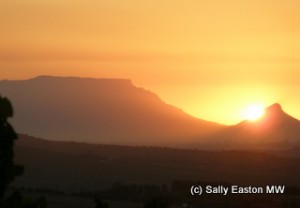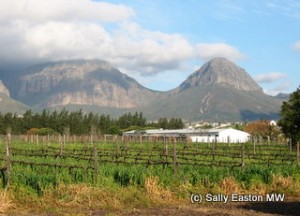Cap Classique – South Africa's premium bubbly
Cap Classique sparklers are a premium category of South African sparkling wines. It’s a generic term for any wine in the Cape that is produced by the traditional method, that is, in the same way as Champagne. To distinguish them from other, invariably less expensive, ways of getting the bubble in the bottle, Cap Classique will be on the label.
It all started with Simonsig Wine Estate in Stellenbosch, who made the first traditional method sparkler in 1968, releasing it in 1971, and who were the first to have the three traditional grape varieties used to make Champagne: pinot noir, chardonnay and pinot meunier.

Table Mountain
Cap classique is a pretty niche product, about 2.5 million bottles being made each year. Compare that with Champagne’s approximate 400 million bottle production. Nonetheless it’s an exciting category, as Alec Louw, the commercial manager for Graham Beck Wines explained: “there are a lot of new producers making cap classique, it’s really growing.” Indeed, exports of total bubblies (all methods), nearly doubled last year compared to 2007.
By the early 1980s, Villiera had arrived on the traditional method sparkling scene. Co-proprietor Cathy Brewer said they were the first to make cap classique on a commercial scale in 1984, and this style now accounts for more than 40% of their business. She said “for ten years we paid royalties to a French winemaker, Jean-Louis Denois,” a chap who has a strong reputation for sparkling production, which gave them a head-start in the quality stakes.
Into the next decade and Graham Beck’s first sparkling vintage was in 1991. Sparkling wine had been the idea behind their Robertson property where the focus is solidly on sparkling production of pinot noir and chardonnay on the limestone soils. Louw added “sparkling wine is our calling card. About 40% of our business is sparkling.”
By 1992, an association of producers was created to promote cap classique sparkling wines. There are now more than sixty members, though a producer does not need to be a member of the association to put cap classique on the label. The advantages of membership include a group tasting of base wines where members give and receive feedback, as well as a collective marketing mass.
There are agreed minimum quality standards, which so far form a voluntary code. Though Pieter Ferreira, cellar master at Graham Beck, and secretary of the Cap Classique Producers’ Association said: “The only criterion monitored by certification is the time on the lees (12 months) and that the wine should have a minimum of 3 bars of pressure.” He added “we are currently investigating a possible two-tier commitment charter, where we will have a higher level than the standard quality commitment. I believe every improvement we make is one step in the right direction for quality and that we are a great alternative to anything else.”

Cape Winelands
With most consumption being on the domestic market Brewer said: “In our climate, fresh and citrusy flavours are good.” In the wines tasted below, strong autolysis characters were generally not overt, and this fresher, fruitier style of traditional bubbly is a widely appealing one, as savoury, yeasty, leesy characters can be an acquired taste.
Tasting notes
Here are my tasting notes from a few cap classique wines I tasted at a recent generic tasting. The producers below make other cuvées, and there are more then 60 producers in South Africa making traditional method bubblies.
All the bubblies tasted were between 11.5 and 12.5% alcohol, which helps keep them fresh and refreshing. This alcohol level is similar to Cava and Champagne.
There are a couple of new rosé products in this line up. Certainly for the UK market, we like bubbly, we like pink, so anything pink and bubbly is sure to have a good start.
Boschendal Le Grand Pavilion Rosé NV
15% chardonnay, rest pinotage, shiraz, pinot noir
12 months on lees
A new product. Fresh attack, strawberries, gentle mouthfeel, crunchy fruit in full-flavoured style.
Graham Beck Brut NV
60% chardonnay, 40% pinot noir
18 months on lees.
Lemon toast, lemon curd, fine soft mousse, but not very persistent. Fresh citrus flavours, honest and balanced.
Graham Beck Brut Rosé NV
55% chardonnay, 45% pinot noir
18 months on the lees
Bit more time on pinot noir skins, for colour. Fresh strawberries, hints of bread dough, full flavour, good intensity of strawberry. Widely appealing upfront fruity flavours, balance giving rounded mouthfeel.
Môreson Cuvee Cape NV
80% pinotage, 20% chenin blanc
Deep lemon colour, big mousse, big flavour, bit short.
Môreson Blanc de Blancs NV
90% chardonnay, 10% chenin blanc
Citrus and cream, fresh, full body, rich and full creamy textured. Fine mousse with a bit of mid palate biscuit and good length.
Môreson Brut Rose 2005
80% pinotage, 20% chardonnay
Dark pink colour, overt strawberry compote, not very subtle, big mousse also not particularly fine.
Morgenhof Brut Reserve 2005
60% chardonnay, 40% pinot noir
24 months on lees
Deep lemon colour, rich toast with butter, oil, nuttiness and savoury notes, which give away the fact that half the wine underwent a malo-lactic in French oak barrel. Full-bodied, still with some lemon-freshness, and the oil a back texture. It’s not a refreshing aperitif style.
Pongrácz Brut NV (made by Distell)
60% pinot noir, 40% chardonnay
18 to 24 months on lees
Fresh, light biscuit palate, with citrus and strawberry; zesty and uplifting.
Pongrácz Rosé NV (made by Distell)
A new product. Pale salmon colour, not so much autolysis character, fresh and strawberry; attractive and refreshing in an easy way.
Simonsig Kaapse Vonkel Brut 2007
58% pinot noir, 39% chardonnay, 3% pinot meunier
15 to 24 months on lees;
Butter biscuits, fresh acidity, nice rounded flavoursome palate, red berry foam and savoury almond notes; good balance with noticeable refinement and decent length.
Simonsig Kaapse Vonkel Brut Rosé 2007
90% pinotage, 10% pinot noir
Fairly deep pink, broad palate, quite rustic.
Villiera Tradition Brut NV
2/3rds pinot noir and pinotage, 1/3rd chardonnay
18 months on lees
Hint gunsmoke, strawberry and redcurrants, allspice note, persistent mousse, citrus peel on mid palate, nice balance and density with good length.
Villiera Tradition Rosé Brut NV
2/3rds pinotage, rest pinot noir and chardonnay
18 months on lees
Deep salmon, rich gentle spice, hint savoury and broad.
Comments
10 Responses to “Cap Classique – South Africa's premium bubbly”




December 4, 2010 at 4:26 pm
Hi Sally! I’m your pupil at WSET ODD. As I have postponed my exams by 6 months, I’m not able to focus my studies on the present Unit 3; by now I have to concentrate on Units 1 and 5. This text of yours about South African sparklers will certainly be very useful. Best wishes, Tufi (Brazil)
December 5, 2010 at 7:20 pm
Hi Tufi, I thought your name was familiar. I’m delighted you found the article useful. Did you find my article on Italian bubblies too? http://www.winewisdom.com/articles/regional-profiles/italys-sparkling-wines/
Sally
May 2, 2011 at 1:20 pm
Tufi!! You are everywhere!! This article certainly is useful. Jacquie.
July 16, 2012 at 9:50 am
Dear Sally
I have been looking for some information on South African Cap Classiques for a post that I want to write on my own blog. I found the CC association extremely unhelpful, and learned a great deal from your article.
Many thanks,
Alison
July 20, 2012 at 11:02 am
Hello Alison, I’m sorry you found the Cap Classique association unhelpful. They have been very helpful to me, and they seem to be serious about pushing the quality of their members’ wines, which is always a good thing. Maybe you just had an unlucky moment? Sally
July 16, 2012 at 9:55 am
ps. I have added a link to your site on my blog. I hope that is ok
July 26, 2012 at 3:02 pm
Hi Sally
I think it was just an unlucky moment. I have subsequently contacted Pieter Ferreira who has been most helpful.
Kind regards,
Alison
July 26, 2012 at 3:10 pm
Great. I’m delighted you managed to make contact with Pieter.
March 7, 2015 at 3:52 am
Thanks for your articles. I am a WSET diploma candidate in Canada and am finding your sit most useful.
March 7, 2015 at 3:55 am
Thanks for your articles. I am a WSET diploma candidate in Canada and am finding your site most useful.